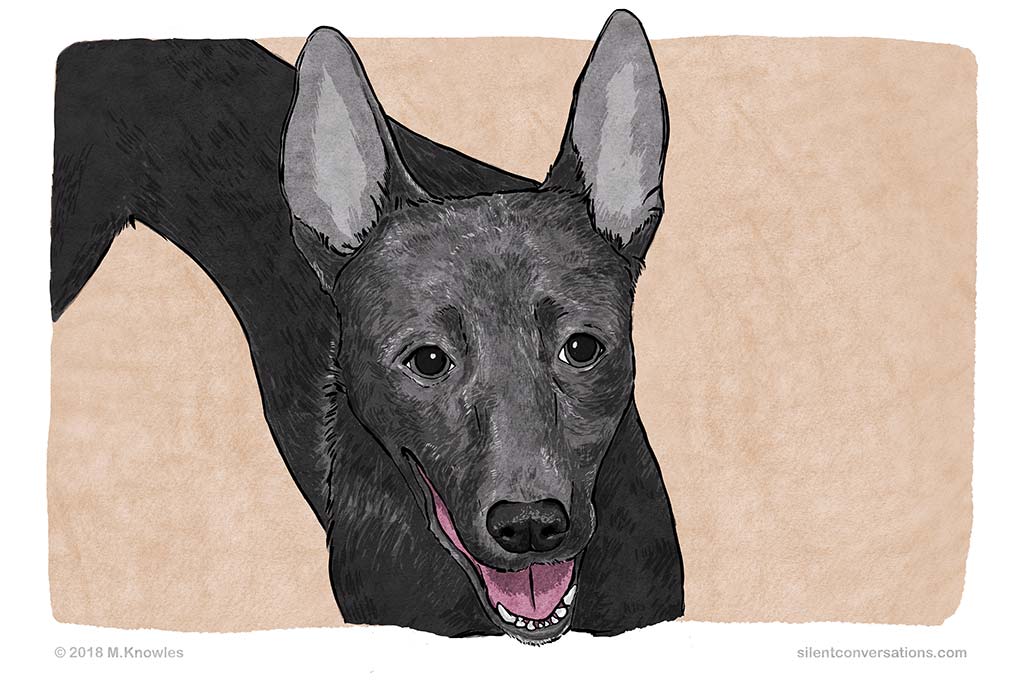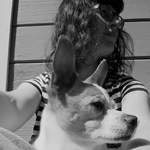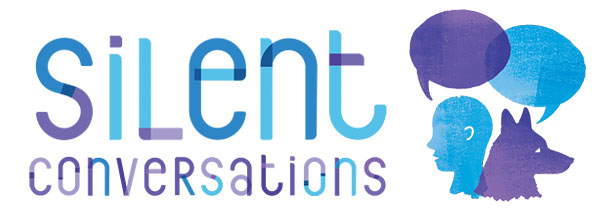
Eyes – Pupils Dilated – Dog Body Language
With regard to observing dog body language, pupil dilation can provide vital clues as to the dog’s emotional state. Dilation of pupils can occur in low light conditions to assist with vision by allowing more light into the eyes. In other instances it occurs as an involuntary response due to the sympathetic nervous system being activated. Dilated pupils can indicate the dog is feeling some form of stress*, fear or arousal.
Pupil dilation can be a subtle change in size, and at other times it is overt, with the pupils appearing so large that hardly any iris eye colour is visible. One cannot just observe one body part, such as dilated pupils in isolation; the whole body, including body language and signals, should be observed in their totality in order to offer a complete interpretation. Sometimes the body language signals, paired with dilated pupils, can be very subtle, so I like to pay attention to the dog’s body movements as part of the observation. The movement seems to be at two ends of the spectrum: At one end, the dog may appear frozen or still and not move much. At the other end, the dog may seem jittery and unable to be still, to the extent that he reveals noticeably tense muscles and muscle twitches, which may be caused by a build up of adrenaline in the system, activated by the sympathetic nervous system.
Caution is advised when trying to observe a dog’s eyes. It is worth paying attention to being polite by avoiding direct eye contact and any prolonged staring, especially if a dog is already experiencing some discomfort. Give the dog space, and use your peripheral vision to observe without giving direct eye contact. You can squint your eyes and blink if giving short amounts of eye contact. It is also advisable to turn your head away ever so slightly and keep your body turned side-on to the dog, so that you are not adding to the pressure the dog may be experiencing with your body language.
Here are a few examples of situations where a dog’s pupils may appear dilated:
- This is an observation of a dog showing fear in a vet’s examination room. The dog is panting heavily, with the tongue starting to look spatulate. The eyes are wide, the pupils dilated, and he keeps scanning the environment. As he pants, his mouth is wide open, and there are quite a few deep creases forming around the corners of the mouth, under the eyes, and on the brow area. The ears are held to the side; on occasion they move from the side to the front to listen to sounds in the veterinary rooms. He seems restless and sits on the floor before pacing around the room with tail tucked and body slightly lowered. With his tail still tucked, he walks over to the door and sniffs underneath it. Then he paces back near to his guardian. After stopping for a while, he continues pacing around the room whilst panting.
On her blog, Eileen has shared informative examples of her dog, Clara’s, facial expressions when visiting a vet. The photos illustrate clearly how stress is displayed in the facial features. There is also a comparison of Clara’s facial expressions when relaxed, as opposed to stressed. In the photos that illustrate the stressed expressions, the pupils appear dilated. For excellent photographic examples of dilated pupils click here.
- A dog is very excited to go out for a walk. When the guardian walks into the room with the leash in hand, the dog starts running around the room, wagging his tail very fast, and jumps up at the person. The dog is now panting and his pupils are heavily dilated. He jumps up some more, making it difficult for the guardian to clip the leash on. With his eyes wide, the dog briefly runs around the room again, and then he does a quick shake off. The dilated pupils, panting, fast movement, and inability to stay still indicate the dog is over aroused due to excitement.
- At a shelter, a volunteer returns to the room with a dog. The dog starts panting the minute she is back in her room. Her pupils become heavily dilated, and her eyes appear wide. The areas under her eyes look puffy, and muscle tension causes deep furrows start to show on her face. She paces around the room for a few moments, then chooses to sit. Her ears are held to the side but move slightly forward, and her mouth closes for a moment as she listens to the sounds coming from the shelter corridors. She continues to pant and then gives a big yawn. This is an observation of a dog at a shelter becoming stressed when she returns to her room and is left there on her own.
These are just a few examples; there may be many more. Start observing to see if you can notice pupil dilation in different contexts. As discussed below, interpretations such as the above examples should not be attempted without careful observation and consideration of all aspects of the situation.
What is meant by stress*?
When I mention stress, this does not necessarily imply negative emotion. I mean stress in the physiological sense. So certain body language signals can mean the dog is feeling some sort of emotional discourse. This discourse could range from positive to negative emotion. Both excitement and fear could have similar effects on the body, with various hormones being released and activating the sympathetic nervous system. The dog may be feeling uncomfortable/fearful or it could also be excited about something. When analyzing stress in body language, it is worth noting the frequency and intensity of the various body language signals.
A few notes to consider when observing dog body language:
Observation before interpretation
Interpretations should be offered only once you have observed the complete interaction and taken note of the wider picture. To offer an unbiased interpretation of the body language, observe and take note of the situation, taking into account the dog’s whole body, the body language signals and environment first before offering an interpretation. List all the body language you see in the order that it occurs; try to be descriptive as possible without adding any emotional language. For instance, saying a dog looks happy is not descriptive and would be seen as an interpretation rather than an observation.
You could however list what you observe: ears to the side, eyes almond shaped, slight shortening of the eye, mouth open, long lips, tongue out, body moving loosely, body facing side-on, tail wagging at a slow, even pace at body level.
From the observation I could interpret that the dog seems relaxed or comfortable. I still prefer to say relaxed rather than happy, as I feel you will truly never know exactly what the dog may be feeling on the inside emotionally. It is quite likely the dog may be feeling happy, but I prefer to comment on how the dog is behaving in response to the situation rather than presuming internal emotional states.
The importance of viewing body language within context
Interpretations can vary depending on the context. It is possible for certain body language to be used in different contexts and have subtle differences in meaning within those contexts. Individual body language signals should not be observed in isolation; the wider picture should be considered. Take note of what the dog’s body as a whole is saying. Keep in mind each dog is an individual with varying skills and experiences. What may be typical for one individual may not be for another. In order to observe body language in context, consider the following: the situation, body language signals, the body language expressed by all parts of the dog’s body, the environment, and the individuals involved. It is worth noting how the body language changes with feedback from the environment or the other individuals interacting.

Martha Knowles
Author
My vision is to create a community of dog guardians who share their observations and interpretations of their dogs’ silent conversations. Hopefully, these experiences and stories will provide some insight into dog communication, which is often overlooked by the untrained eye because it is unfamiliar to humans. We are accustomed to communicating mainly with sound, so we are not attuned to the silent subtle gestures and body language used by dogs to communicate. If you take the time to observe, you will start to see these 'silent conversations' going on around you. My dream is for dog communication to become common knowledge with all dog guardians and as many people as possible. Surprisingly, there are still some professionals working in various dog-related careers who are uneducated about dog body language. Greater awareness of how dogs communicate will help to provide better understanding and improve the mutual relationship between dogs and humans. This will promote safer interactions between our two species and hopefully remove some of the expectations placed on dogs within human society. I would like dog guardians to feel empowered with their knowledge of dog communication so that they can be their dogs’ advocates and stand up for themselves and their dogs when it really matters.
